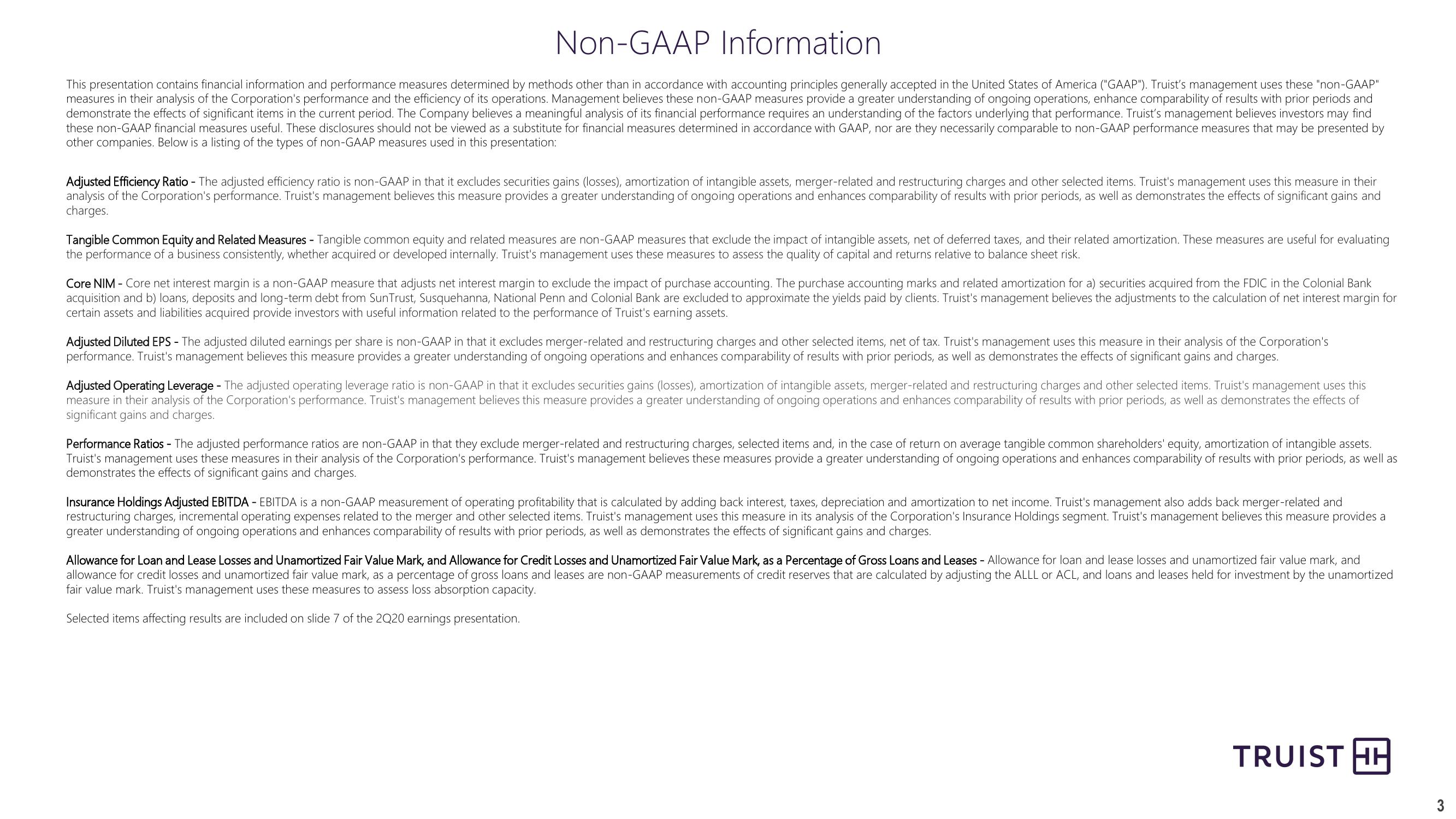Barclays Global Financial Services Conference
Non-GAAP Information
This presentation contains financial information and performance measures determined by methods other than in accordance with accounting principles generally accepted in the United States of America ("GAAP"). Truist's management uses these "non-GAAP"
measures in their analysis of the Corporation's performance and the efficiency of its operations. Management believes these non-GAAP measures provide a greater understanding of ongoing operations, enhance comparability of results with prior periods and
demonstrate the effects of significant items in the current period. The Company believes a meaningful analysis of its financial performance requires an understanding of the factors underlying that performance. Truist's management believes investors may find
these non-GAAP financial measures useful. These disclosures should not be viewed as a substitute for financial measures determined in accordance with GAAP, nor are they necessarily comparable to non-GAAP performance measures that may be presented by
other companies. Below is a listing of the types of non-GAAP measures used in this presentation:
Adjusted Efficiency Ratio - The adjusted efficiency ratio is non-GAAP in that it excludes securities gains (losses), amortization of intangible assets, merger-related and restructuring charges and other selected items. Truist's management uses this measure in their
analysis of the Corporation's performance. Truist's management believes this measure provides a greater understanding of ongoing operations and enhances comparability of results with prior periods, as well as demonstrates the effects of significant gains and
charges.
Tangible Common Equity and Related Measures - Tangible common equity and related measures are non-GAAP measures that exclude the impact of intangible assets, net of deferred taxes, and their related amortization. These measures are useful for evaluating
the performance of a business consistently, whether acquired or developed internally. Truist's management uses these measures to assess the quality of capital and returns relative to balance sheet risk.
Core NIM - Core net interest margin is a non-GAAP measure that adjusts net interest margin to exclude the impact of purchase accounting. The purchase accounting marks and related amortization for a) securities acquired from the FDIC in the Colonial Bank
acquisition and b) loans, deposits and long-term debt from SunTrust, Susquehanna, National Penn and Colonial Bank are excluded to approximate the yields paid by clients. Truist's management believes the adjustments to the calculation of net interest margin for
certain assets and liabilities acquired provide investors with useful information related to the performance of Truist's earning assets.
Adjusted Diluted EPS - The adjusted diluted earnings per share is non-GAAP in that it excludes merger-related and restructuring charges and other selected items, net of tax. Truist's management uses this measure in their analysis of the Corporation's
performance. Truist's management believes this measure provides a greater understanding of ongoing operations and enhances comparability of results with prior periods, as well as demonstrates the effects of significant gains and charges.
Adjusted Operating Leverage - The adjusted operating leverage ratio is non-GAAP in that it excludes securities gains (losses), amortization of intangible assets, merger-related and restructuring charges and other selected items. Truist's management uses this
measure in their analysis of the Corporation's performance. Truist's management believes this measure provides a greater understanding of ongoing operations and enhances comparability of results with prior periods, as well as demonstrates the effects of
significant gains and charges.
Performance Ratios - The adjusted performance ratios are non-GAAP in that they exclude merger-related and restructuring charges, selected items and, in the case of return on average tangible common shareholders' equity, amortization of intangible assets.
Truist's management uses these measures in their analysis of the Corporation's performance. Truist's management believes these measures provide a greater understanding of ongoing operations and enhances comparability of results with prior periods, as well as
demonstrates the effects of significant gains and charges.
Insurance Holdings Adjusted EBITDA - EBITDA is a non-GAAP measurement of operating profitability that is calculated by adding back interest, taxes, depreciation and amortization to net income. Truist's management also adds back merger-related and
restructuring charges, incremental operating expenses related to the merger and other selected items. Truist's management uses this measure in its analysis of the Corporation's Insurance Holdings segment. Truist's management believes this measure provides a
greater understanding of ongoing operations and enhances comparability of results with prior periods, as well as demonstrates the effects of significant gains and charges.
Allowance for Loan and Lease Losses and Unamortized Fair Value Mark, and Allowance for Credit Losses and Unamortized Fair Value Mark, as a Percentage of Gross Loans and Leases - Allowance for loan and lease losses and unamortized fair value mark, and
allowance for credit losses and unamortized fair value mark, as a percentage of gross loans and leases are non-GAAP measurements of credit reserves that are calculated by adjusting the ALLL or ACL, and loans and leases held for investment by the unamortized
fair value mark. Truist's management uses these measures to assess loss absorption capacity.
Selected items affecting results are included on slide 7 of the 2Q20 earnings presentation.
TRUIST HH
3View entire presentation